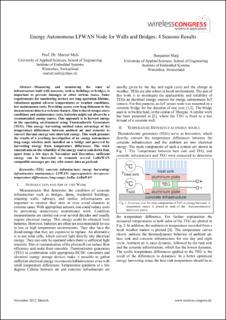Bitte benutzen Sie diese Kennung, um auf die Ressource zu verweisen:
https://doi.org/10.21256/zhaw-26937| Publikationstyp: | Konferenz: Paper |
| Art der Begutachtung: | Peer review (Abstract) |
| Titel: | Energy autonomous LPWAN node for walls and bridges : 4 seasons results |
| Autor/-in: | Meli, Marcel Maij, Benjamin |
| et. al: | No |
| DOI: | 10.21256/zhaw-26937 |
| Tagungsband: | Wireless Congress 2022 |
| Angaben zur Konferenz: | Wireless Congress 2022 : Systems & Applications, Munich, Germany, 16-17 November 2022 |
| Erscheinungsdatum: | 16-Nov-2022 |
| Verlag / Hrsg. Institution: | WEKA |
| Sprache: | Englisch |
| Schlagwörter: | Energy harvesting; Energy autonomous; TEG; Low power; LPWAN; Bridge; Maintenance; Storage; Temperature difference; LoRaWAN; civil infrstructure |
| Fachgebiet (DDC): | 621.3: Elektro-, Kommunikations-, Steuerungs- und Regelungstechnik |
| Zusammenfassung: | Measuring and monitoring the state of infrastructure built with concrete, such as buildings or bridges, is important to prevent damages or other serious issues. Some requirements for monitoring devices are long operation lifetime, robustness against adverse temperatures or weather conditions, low maintenance costs. Providing access over long distances to the measurement data is a welcome feature. Due to harsh temperature conditions and maintenance costs, batteries might not always be a recommended energy source. One approach is to harvest energy in the operating environment using Thermoelectric Generators (TEG). This energy harvesting method takes advantage of the temperature differences between ambient air and concrete to convert thermal energy into electrical energy. This work presents the results of a yearlong investigation of an energy autonomous long range wireless node installed on a bridge and powered by harvesting energy from temperature differences. The work concentrates on the reliability of the energy source and shows that, apart from a few days in November and December, sufficient energy can be harvested to transmit several LoRaWAN compatible messages per day with sensor data as payload. |
| URI: | https://digitalcollection.zhaw.ch/handle/11475/26937 |
| Volltext Version: | Publizierte Version |
| Lizenz (gemäss Verlagsvertrag): | Lizenz gemäss Verlagsvertrag |
| Departement: | School of Engineering |
| Organisationseinheit: | Institute of Embedded Systems (InES) |
| Enthalten in den Sammlungen: | Publikationen School of Engineering |
Dateien zu dieser Ressource:
| Datei | Beschreibung | Größe | Format | |
|---|---|---|---|---|
| 2022_Meli-Maij_EH-bridges-4-seasons_WirelessCongress.pdf | 516.77 kB | Adobe PDF |  Öffnen/Anzeigen |
Zur Langanzeige
Meli, M., & Maij, B. (2022, November 16). Energy autonomous LPWAN node for walls and bridges : 4 seasons results. Wireless Congress 2022. https://doi.org/10.21256/zhaw-26937
Meli, M. and Maij, B. (2022) ‘Energy autonomous LPWAN node for walls and bridges : 4 seasons results’, in Wireless Congress 2022. WEKA. Available at: https://doi.org/10.21256/zhaw-26937.
M. Meli and B. Maij, “Energy autonomous LPWAN node for walls and bridges : 4 seasons results,” in Wireless Congress 2022, Nov. 2022. doi: 10.21256/zhaw-26937.
MELI, Marcel und Benjamin MAIJ, 2022. Energy autonomous LPWAN node for walls and bridges : 4 seasons results. In: Wireless Congress 2022. Conference paper. WEKA. 16 November 2022
Meli, Marcel, and Benjamin Maij. 2022. “Energy Autonomous LPWAN Node for Walls and Bridges : 4 Seasons Results.” Conference paper. In Wireless Congress 2022. WEKA. https://doi.org/10.21256/zhaw-26937.
Meli, Marcel, and Benjamin Maij. “Energy Autonomous LPWAN Node for Walls and Bridges : 4 Seasons Results.” Wireless Congress 2022, WEKA, 2022, https://doi.org/10.21256/zhaw-26937.
Alle Ressourcen in diesem Repository sind urheberrechtlich geschützt, soweit nicht anderweitig angezeigt.